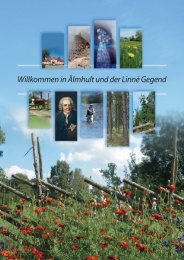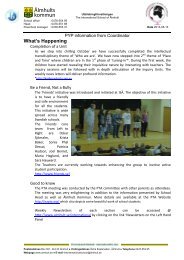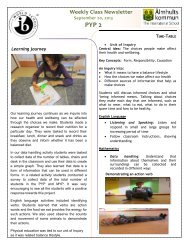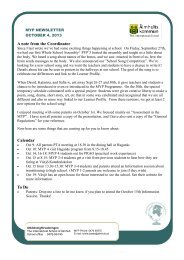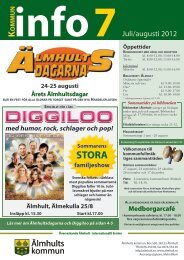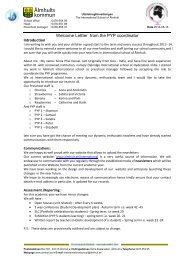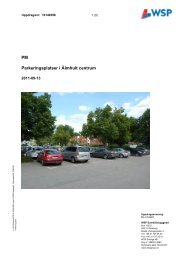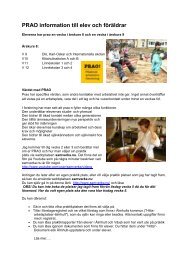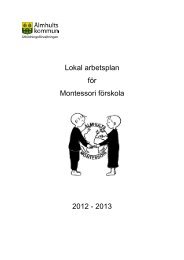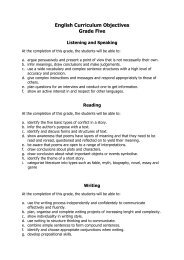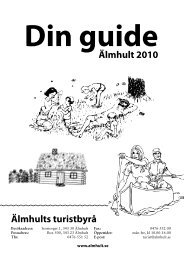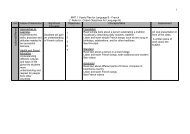MYP X XXXXXXX Yearly Plan
MYP X XXXXXXX Yearly Plan
MYP X XXXXXXX Yearly Plan
You also want an ePaper? Increase the reach of your titles
YUMPU automatically turns print PDFs into web optimized ePapers that Google loves.
Maps<br />
<strong>MYP</strong> 1 Geography <strong>Yearly</strong> <strong>Plan</strong><br />
Unit AOI Significant Concepts Objectives Concepts/Skills Assessment<br />
ATL: Searching To gain an<br />
A1-2 Students will complete various activities so that they are Students will draw a<br />
for location using understanding of local C-T1 &4 familiar with using a map.<br />
map of the school<br />
various skills, and global locations. D1-3<br />
ground including<br />
grid systems,<br />
specific features.<br />
degrees/minutes, To develop skills on<br />
indexes etc. how to use a map.<br />
Unit Q: Where<br />
am I in the<br />
world?<br />
What is latitude and longitude? Students will learn about<br />
these terms, what they mean and how to use them<br />
effectively. They will also study degrees and minutes as<br />
well as recapping the earth’s rotation.<br />
How can we describe where we are on a map in various<br />
ways? Students will use local maps to calculate distance<br />
accurately.<br />
What is scale? How can I use scale? Students will<br />
answer these questions using and creating their own<br />
maps.<br />
Draw 15 individual<br />
connections on a<br />
world map, table<br />
them and present at<br />
least 5 to the class.<br />
Test on using an<br />
atlas, map skills,<br />
capitals, countries<br />
and continents.
People<br />
ATL:<br />
Researching<br />
skills, graphing<br />
skills.<br />
Env: Begin to<br />
understand the<br />
concept of<br />
population<br />
density and<br />
distribution.<br />
Guiding Q: Can<br />
the world cope<br />
with the change<br />
of population<br />
size, density and<br />
distribution?<br />
Population density<br />
and distribution.<br />
A1-2<br />
C-T1-4<br />
B-P1<br />
C-I1<br />
To gain an awareness of the concept of population.<br />
To participate actively in discussions.<br />
To read, understand, draw and use population pyramids<br />
in different ways.<br />
See connections and link problems in society with<br />
population structure.<br />
ATL: To participate actively in discussions.<br />
1. What is the world's total population? How and why is it<br />
changing? What will it be in 50 years' time? 2. Which<br />
parts of the world are densely and which sparsely<br />
populated and why? 3. What is a settlement? Where do<br />
we build our settlements and why? 4. Where should all<br />
the new houses go? 5. How is land used in a town or<br />
city? Where are the different land-use zones found and<br />
why? How has the pattern developed? How is the pattern<br />
changing? How are different groups of people affected?<br />
Draw a population<br />
pyramid and explain<br />
it.<br />
Individual poster on<br />
the distribution and<br />
structure of the<br />
population in a certain<br />
country.<br />
Individual<br />
presentation of<br />
poster.
Flood disaster: How do people cope?<br />
Env: What is the<br />
impact of floods<br />
on people’s<br />
lives?<br />
Guiding Q: What<br />
causes a flood?<br />
Students consider the<br />
causes and effects of<br />
flooding and how<br />
people deal with<br />
them.<br />
A1-2<br />
C-T2<br />
B-P2<br />
D-4<br />
What causes flooding?<br />
· to ask geographical questions and make predictions<br />
· to collect, record and present data<br />
· to select and use appropriate fieldwork techniques<br />
· to summarise their understanding in annotated<br />
diagrams<br />
· to share and refine ideas and information in small<br />
groups<br />
· what happens to water when it reaches the ground?<br />
· to describe the components and links in the water cycle<br />
· to identify the main causes of flooding<br />
How do individuals and communities respond to flood<br />
hazards?<br />
· how individuals and communities respond to a hazard<br />
over different timescales<br />
· to observe and speculate (about hazard damage)<br />
· to share ideas<br />
· to classify<br />
· to evaluate critically<br />
Draw a summary<br />
diagram, with notes to<br />
record all the causes<br />
of flooding<br />
mentioned, including<br />
the role of infiltration.<br />
Poster<br />
Group Presentation<br />
Are the effects of flooding greater on the UK compared<br />
with Bangladesh?<br />
· to develop a range of thinking skills, e.g. to make<br />
predictions, to evaluate, to compare, to discuss and<br />
share ideas, to transfer and adapt learning to new<br />
contexts<br />
· to use an atlas to locate places and analyse<br />
photographs<br />
· to determine Bangladesh's global context<br />
· to identify the effects of floods in Bangladesh<br />
· to assess the relationship between development and<br />
flood response<br />
Is there a pattern in how people respond to all natural<br />
hazards?



